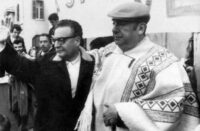One of the lasting effects of the continuing Cold War against all socialist thought and culture is the West’s denial of the art of socialist countries. This affects all genres in all the socialist countries. The work of these artists is rarely readily available to the general public, and sidelined in university courses, dismissed highhandedly as “Soviet Era” and therefore by definition deplorable.
Let me introduce you to the amazing Kyrgyz writer Chingiz Aitmatov, born in 1928. His father, a Kyrgyz communist, became a victim of Stalin’s terror, executed in 1938 along with 137 other Kyrgyz intellectuals and buried in a mass grave.
In 1942, young Chingiz was given a position in the district administration. He went back to school after the war, studied veterinary and agricultural science. In 1956, he attended a two-year course for young authors in Moscow. His world-famous novella Jamila was his graduation submission. Many more stories and novellas followed, written both in Kyrgyz and Russian. In 1980, The Day Lasts More than a Hundred Years was published. Due to its at times controversial subject-matter and also the inclusion of tragic elements, Aitmatov’s work often came under criticism. However, his outstanding literary achievement was also honoured with several high awards. Aside from writing fiction, Aitmatov was actively involved in politics and died in Nuremberg on 10 June 2008 at the age of 79.
Aitmatov’s novel The Day Lasts More than a Hundred Years is set in the Kazakh steppe at an inhospitable eight dwelling railway junction not far from the Cosmodrome. The junction’s name, Boranly-Burannyi (snowstorm), highlights the rough life and weather that the small village community must confront. However remote, it is spared neither national nor international upheavals. The inhabitants come to this wasteland for different reasons, and not everyone is cut out for the hardships of life there. The death of one of one of their elders, Kazangap, prompts his closest friend, Burannyi Yedigei (Snowstorm Yedigei), to honour ancient tradition and bury him in the ancestral graveyard. He saddles and decorates his camel and sets off. The novel describes Yedigei’s memories on his way to the cemetery. It is the day that transcends Kazangap’s life and reflects on the times.
Aitmatov condenses the action by linking two storylines – one set in the present as well as one set in the early 1950s. To this are added Kazakh myths as well as a USSR-US space cooperation programme that has a utopian dimension, although it too takes place in the present of the novel. A fabric emerges in which the past and the future intertwine, in which the best and the most horrendous that human beings are capable of emerges, as well as the possibility of intergalactic cooperation with a civilisation that is more advanced and peaceful than Earth’s inhabitants.
The theme of peaceful community, human strength and the solidarity of ordinary people runs through all plot levels, as does the potential to destroy other humans. The legends are about power and abuse of power, violence and resistance. The legend of the Mankurt is centred on the erasure of memory and the subduing of those who survive cruel torture. But it is also about a mother’s fight for her son. Parallels are drawn with Stalinism, which is depicted here in the fate of the family of Abutalip and Zaripa Kuttybayev, and in which Aitmatov undoubtedly creates a monument to his own father.
Nevertheless, manifestations of goodness are also found again and again. Aitmatov’s positive characters are characterised above all by their love for other people, for children, for animals and for nature. Violations of this elementary love are offences against humanity. At the same time and closely connected to this is their sense of responsibility for the important work that defines their lives. People of different origins and fates have ended up at this remote railway junction in the middle of the steppe, people for whom work and life here offered a new beginning despite all the hardships. Here, they harness all their strength to ensure that the trains can travel from West to East and back. Yet further blows of fate await them.
The space travellers represent the two great powers, here cooperating in a unique joint project to explore a newly discovered planet with inestimable mineral deposits for the purpose of energy production. With the great self-sacrifice of Aitmatov’s heroes, they try to persuade their governments to be open to the new civilisation.
The perversion of mutual support and the dissolution of social cohesion in the interest of money thematically determine Aitmatov’s last novel When Mountains Fall. Cash nexus now rules where trust, mutual respect and help used to be. The snow leopard, a protected species, a symbol of the high mountain regions of Central Asia and revered there since time immemorial, is sacrificed to Mammon, even if this means the destruction of the region’s soul in the immediate future. The old values of a symbiosis between humankind and nature are sacrificed.
Aitmatov’s view of humanity is marked by tragic features. Nevertheless, it is not dystopian. With his work, he sharpens readers’ awareness of the strengths of humanity: love, mutual trust and solidarity. And he describes how these are mercilessly destroyed by the enemies of humanity. Standing in the shoes of the ordinary people of Central Asia, readers understand even more profoundly our common humanity, which we must defend and protect in common cause. It will not be easy.






